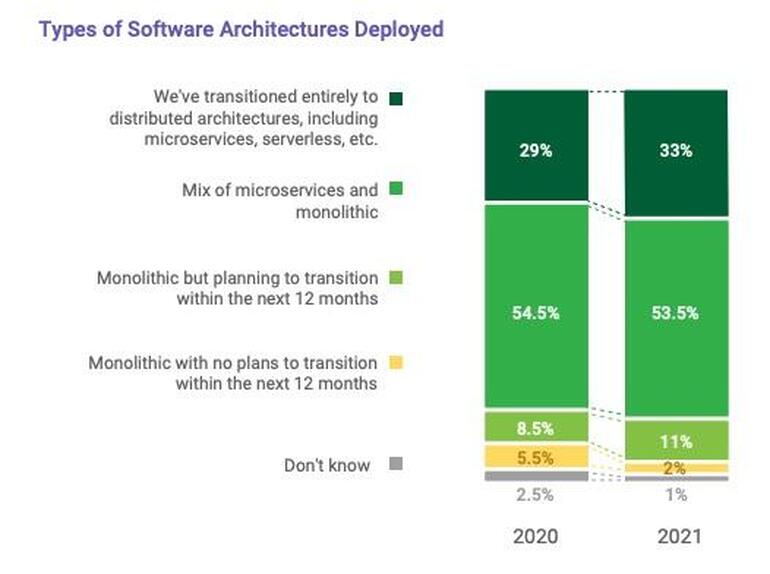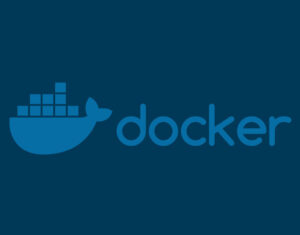The price of failure could get personal if the pace of innovation falls behind, according to a new survey.
” data-credit=”Image: Kong Innovation Benchmark 2021″ rel=”noopener noreferrer nofollow”>
A survey of 400 IT leaders found that CIOs and CTOs see microservices and distributed applications as the architecture of the future.
Image: Kong Innovation Benchmark 2021
The stakes are high for IT professionals running digital transformation projects with consequences ranging from missed bonuses to going out of business, according to a new survey. The current motto for survival is “Move even faster and make sure nothing breaks,” IT leaders told Kong in the company’s 2021 Digital Innovation Benchmark report.
Sixty-two percent of tech leaders said they are at risk of being replaced by competitors who innovate more quickly, according to the survey. Also, 51% of respondents said they will survive only three years before being acquired or simply going out of business if they can’t evolve fast enough. That number goes up to 84% when the make-or-break timeline extends to six years. This number is up from 71% in last year’s survey.
SEE: Top cloud providers in 2020: AWS, Microsoft Azure, and Google Cloud, hybrid, SaaS players (TechRepublic)
The annual digital innovation benchmark asked 400 IT leaders in the US and Europe about these topics:
- The current state of IT initiatives in and challenges
- The ability to innovate
- The strategies that increase agility
- The biggest barriers to achieving key IT objectives
Tech leaders in the survey said that there could be personal consequences for failing at digital transformation due in part to the fact that COVID-19 has removed any margin for error. Sixty-seven percent of respondents overall say that failure could result in them losing a bonus, missing a promotion, or even being fired.
Overall priorities shifted somewhat for 2021. “Improve operational efficiency” is still at the top of the list, just as it was in 2020. In this year’s survey, “improve application performance and reliability” and “improve application security” filled out the next two spots. “Reducing costs” fell to fourth place overall among respondents.
The survey responses came from CIOs, CTOs, VPs of IT, IT directors/architects, and software engineers/developers from organizations across a range of industries.
Barriers to success
The familiar foe of complexity is holding back many transformation efforts with IT leaders listing these as the top five limiting factors:
- Complexity of using multiple technologies: 31%
- Reliance on legacy platforms: 29%
- Lack of automation for trivial manual tasks: 28%
- Lack of resources: 27%
- Lack of the right talent: 25%
The survey report notes that COVID-19 forced organizations to invest more in IT and developer teams. Seventy-five percent of survey respondents expect to see bigger budgets for both teams in the next 12 months.
Shifting to microservices
The survey reinforces what many companies realized at the end of 2020: The pandemic accelerated digital transformation in general and cloud migrations in particular. Almost 40% of tech leaders in the US and Europe said that their companies also implemented microservices sooner than expected due to the pandemic.
A majority of respondents (87%) said that microservice-based applications, distributed applications, and open source software are the future of IT architecture. Thirty-three percent of organizations in the survey have already moved to an entirely distributed architecture with an average of 102 microservices in productions.
The survey found that the top challenges with microservices deployment are security, complexity of managing services across clouds and platforms, and connecting all services to create an end-to-end experience.
Part of the complexity problem for IT teams is the environment that many groups are working in. Forty-six percent are using hybrid deployments and 41% use multicloud environments.
Here is what those environments look like, according to the survey:
- Hybrid with services running on-premise connected with services in the cloud: 46%
- Public cloud provided by Amazon Web Services: 43%
- Public cloud provided by Microsoft Azure: 42%
- Multicloud with services running in one cloud connected to services running in another: 41%
- Public cloud provided by Google Cloud Platform: 35%
- On-premises: 31%
Also see
Source of Article



